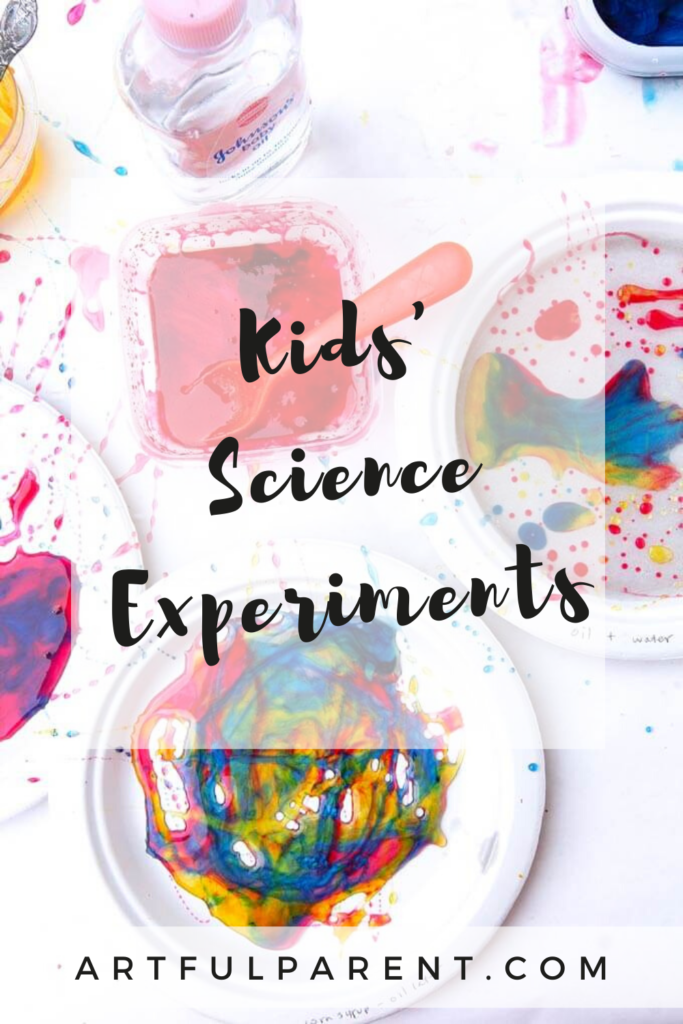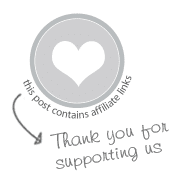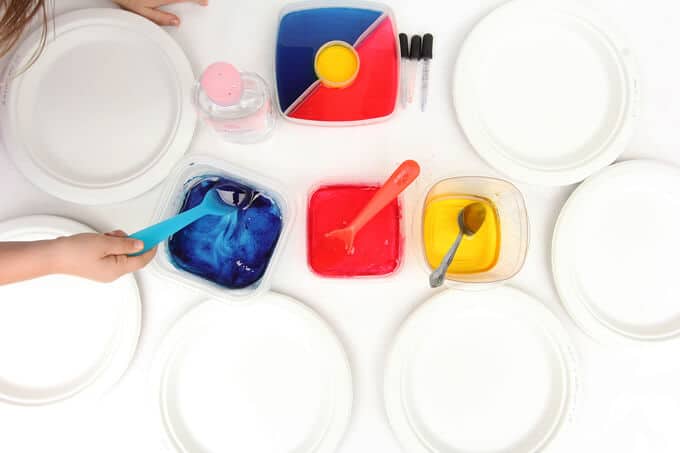Explore scientific concepts in a creative and educational way with these kids’ science experiments at home. Fun and colorful exploration!
Updated February 2023
I used to be intimidated about trying science projects at home with my kids until I learned this simple trick: introduce science through art!
My kids love process art projects, so using art to talk about scientific concepts is both creative and educational. And the more irresistible the project, the better! I mean seriously, what kid can resist making an ooey gooey sticky art mess like this?
Before we get started, here’s a video showing how exciting this project can be, especially if you pay attention to details.
Science Experiments at Home


MATERIALS
- White Plates (Ceramic or Styrofoam work best)
- Baby Oil
- Corn Syrup
- Almond Milk
- Food Coloring
- Spoons and containers
- Eye Droppers (optional)
- Magnifying glass
INSTRUCTIONS
- Cover your work space
Note: This is a messy project!! Be sure to cover your work surface to protect it if necessary.
- Prepare your liquids
Get your colored liquids ready by mixing corn syrup with red, blue, and yellow food coloring in separate containers. Do the same to create colored water.
- Prepare the rest of your materials
To set up the project, place different plates on the table along with the colored corn syrup, colored water, a small cup of almond milk, a bottle of baby oil, spoons, and eye droppers.

- Experiment!
Start experimenting by combining liquids. Encourage your kids to try different combinations in each plate to see how they interact.
- Look Closely
Observe the interactions. Take a magnifying glass and watch the liquids interact up close. We filmed ours using a macro lens and the magnified view is stunning!

Try These Combinations
- Corn Syrup Only: This is just lovely to see. Corn syrup has a thick glossy look to it so layering the three primary colors of corn syrup on top of each other makes for some explosive color combinations.
- Almond Milk + Corn Syrup: Coat the bottom of your plate with a very thin layer of milk (pour off excess if you have too much), then drip corn syrup on the milk. The corn syrup will have a soft look along the edges.
- Baby Oil + Colored Water: The classic experiment. Pour a layer of baby oil in the bottom of your plate, then use eyedroppers to drop the colored water on top. Make sure to pick up the plate and gently tilt it to watch the water droplets move around, unable to combine with the oil.
- Baby Oil + Corn Syrup: Pour a layer of baby oil in the bottom of the plate then drip corn syrup on top. Similar to water, the corn syrup cannot combine with the oil and forms droplets, only these drops take a few seconds to form because the corn syrup has high viscosity.
- Our Favorite: Almond Milk + Corn syrup, then Baby oil and more corn syrup: This is the ultimate layered version. We even did all this and then added milk and water.
This is process art at its best, where the joy is in the making. When you are done, either rinse off the disposable plates and recycle them or wash off your ceramic plates. The corn syrup-only versions will dry over the course of a week if you want to try saving them, but the oily ones will not.

The Science Behind It
There are a few scientific concepts that Ooey Gooey Oily Art demonstrates. As your child is doing the project and their curiosity is naturally piqued, jump in and tell them what’s going on!
- Polarity: Certain molecules are attracted to or repel other molecules. Liquids with similar amounts of polarity are attracted to each other, water and milk for instance, and liquids with different polarity repel each other, oil and corn syrup or pretty much oil and anything!
- Density: Density is the measure of how heavy and closely packed the molecules of a substance are. Water molecules are very densely packed while oil is less dense, making water heavier than oil. When you combine them, the water sinks to the bottom and the oil floats on top.
- Viscosity: Viscosity is the measure of friction in a liquid and determines how fast or slow a liquid flows. Water has a low viscosity and flows quickly while corn syrup has high viscosity and moves slowly.
- Color Mixing: Limiting this project to red, blue, and yellow is the perfect way to show how the primary colors combine to make secondary colors and eventually brown if you continue to combine them.

Learning Through Creative Projects
One of the things I love most about The Artful Parent is Jean’s ability to weave art lessons into everyday life, activities, and other disciplines like engineering and science. I am a huge believer in cross disciplinary projects; I believe that kids learn best when doing projects that span multiple subjects and engage them both creatively and intellectually.
When we did this project together my daughter kept asking me if I knew the liquids wouldn’t mix beforehand. I loved that she asked me to explain what was happening!
So, was introducing a little science into a project as hard as you thought it might be? I hope projects like this will give you the confidence to explore a little science at home with your kids regardless of your background. Your kids will have fun, think creatively, and make some observations about the world!
Related Stories from The Artful Parent
More Science Process Art Activities for Kids
- What is Process Art? (Here’s Why It’s Important for Kids)
- The Best Kids Science Experiments to Try at Home
- The Awesome Rainbow Milk Science Experiment
- Baking Soda & Vinegar Science Experiments for Kids
- 6 Easy Paper Marbling Techniques
- The Ultimate Guide to Sensory Play
Pin It for Later



